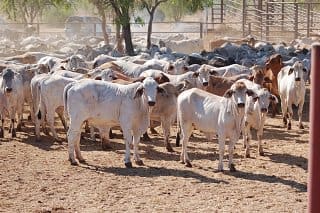THE Federal Department of Agriculture has confirmed that criteria for rejecting northern live export cattle with skin markings or blemishes is being strictly enforced by government vets when inspecting consignments in quarantine prior to export.
 While DAFF said the “conservative approach” to assessing cattle was within the scope of existing rejection criteria details in ASEL (Australian Standards for the Export of Livestock), regional government vets are advising exporters that some cattle historically considered eligible for the live trade are currently not acceptable for export.
While DAFF said the “conservative approach” to assessing cattle was within the scope of existing rejection criteria details in ASEL (Australian Standards for the Export of Livestock), regional government vets are advising exporters that some cattle historically considered eligible for the live trade are currently not acceptable for export.
Indonesian officials are now said to be applying close scrutiny to all incoming consignments of Australian cattle, particularly any with skin markings.
This in turn has prompted DAFF’s clamp down on skin imperfections, which aims to prevent such marks from being mistaken in Indonesia for early clinical signs of LSD.
“We understand that in response to this situation, both exporters and accredited veterinarians have taken a conservative approach and are rejecting some cattle historically considered eligible for export,” DAFF told Beef Central.
Lumpy skin disease has never been detected in Australia, but producers are concerned that increasingly large numbers of cattle are now being rendered virtually unsaleable on the current market if they have marks on their hide, which is highly common in northern cattle.
As efforts continue to resolve ongoing Indonesia and Malaysia supply chain suspensions, DAFF’s spokesperson said it was important to stress that meeting export requirements was not new, nor was the ability for veterinarians to make judgements about the eligibility of livestock for export.
“We believe this to be a sensible risk mitigation approach for the industry’s benefit and aimed at resuming normal trade with Indonesia as soon as possible,” a statement said.
The clamp down has also meant that producers and exporters are currently not trading any cattle unlikely to satisfy DAFF’s reject criteria upon delivery for inspection in export quarantine depots.
There are many reasons why cattle in northern Australia can have hide markings that have nothing to do with disease or ill-health, such as fly bites or general bumps and scrapes.
But cattle rejected from export now have “nowhere to go”, one industry source explained, with northern high-grade Brahman feeder cattle bred specifically for Indonesian customers very difficult to sell back into an already well supplied domestic market, especially given currently weak restocker demand.
Furthermore, producers have expressed concern that rejection of cattle carrying historic fly bites, scars or scratches is also now being enforced for live export consignments to all SE Asian markets, not just to Indonesia.
DAFF: Rejection requirements are not new
Beef Central asked the Department what direct advice it had given to producers to explain the recent increase rates of rejection of cattle with skin imperfections.
“DAFF’s advice to the cattle industry has simply been that all cattle sourced and prepared for export must fully comply with the importing country requirements,” the statement said.
“Indonesia requires that cattle must be examined within the 72 hours prior to export and must not display clinical signs of infectious or contagious diseases or external parasites.
“We advised that if cattle are sent to Indonesia displaying clinical signs resembling LSD, then Indonesia will likely further increase their testing of Australian cattle. Given LSD is present in Indonesia, and most testing is occurring after the cattle have been transported to the feedlots (sometimes several days post arrival and following vaccination) it is likely enhanced testing will deliver more positive results for Australian cattle—as they are infected by LSD in country or anti-bodies produced in response to vaccination provide a positive result.
“We also reiterated to exporters that should a Regional Veterinary Officer identify ineligible animals in an initial inspection of a consignment, they may choose to inspect an increased number of livestock to ensure that the consignment fully complies with the importing country requirements.
“Cattle are susceptible to a range of endemic conditions and pest exposure that gives rise to them having skin lesions, these include buffalo fly lesions, generalised skin infections, ringworm, and sometimes just skin marks caused by injury. These conditions often resemble what may also present as the early clinical signs of LSD.
“We know that Indonesian quarantine officials have been attending the docking and disembarkation of vessels on arrival to Indonesia to inspect and visually identify cattle they want to test. Exporters have advised that if cattle have skin lesions including warts, localised lumps/bumps, and scarring they are being singled out for testing.”
